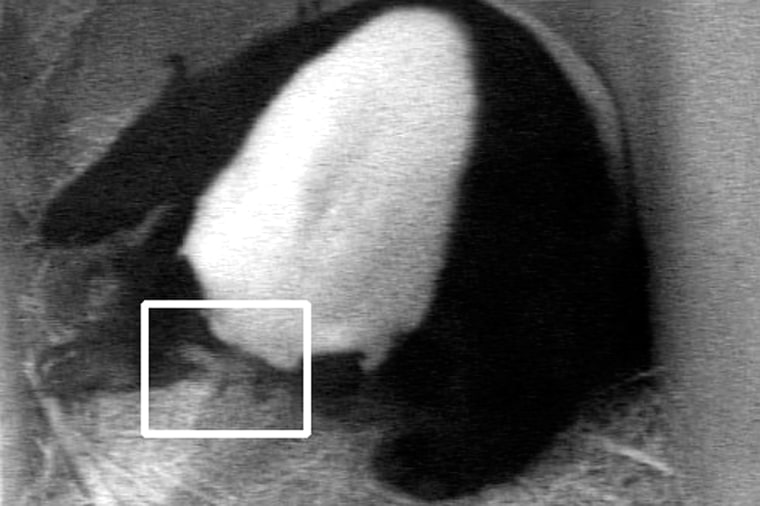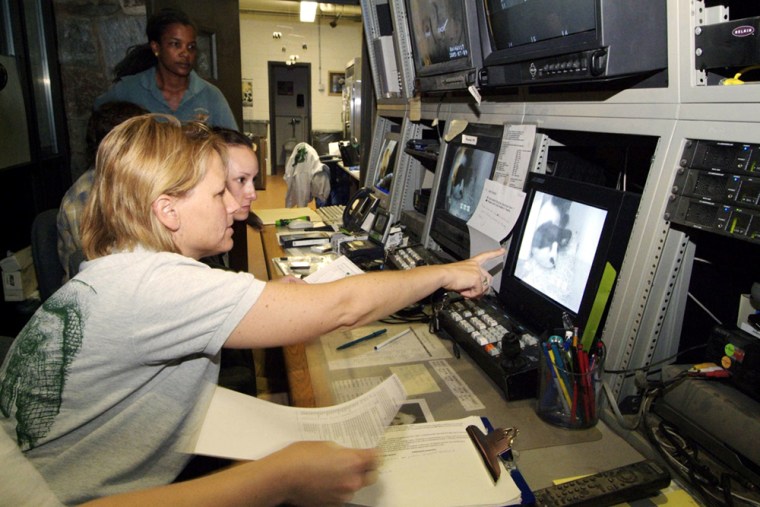Mei Xiang looked surprised, perhaps a bit put off by the shrill cries from the first giant panda cub born at the National Zoo in 16 years.
Within a few minutes, however, the first-time mother was licking and caring for her cub, so fragile that zoo officials had yet to determine its gender or inspect it.
“Mei Xiang is the poster child for a wonderful mom,” Dr. Suzan Murray, the zoo’s chief veterinarian, said Saturday at a news conference hours after the overnight birth of the cub conceived through artificial insemination.
Zoo officials hope that the cub will fare better than the five previous ones born at the zoo since 1983. All died within days.
Their parents — the now-deceased Hsing-Hsing and his female partner, Ling-Ling — were gifts from the Chinese government in 1972 and the original source of the capital’s panda fever.
Cubs typically weigh only 3 ounces to 5 ounces and are about the size of a stick of butter.
The public will have to wait at least three months to see mother and cub, who will remain indoors at the panda exhibit area. Until then the zoo’s Web cam — expected to be accessible online at http://nationalzoo.si.edu/Animals/GiantPandas beginning Sunday morning — will provide the only public view of the two.
The father — Tian Tian — is expected to continue roaming outdoors in the morning and returning to the air-conditioned enclosure during the day’s warmer hours.
Mei Xiang, 6, and Tian Tian, 7, are about half as old and in better health than Ling-Ling and Hsing-Hsing were when they were conceiving.

That made zoo officials hopeful the new cub would become the third giant panda to survive into adulthood in the United States. The others were born at the San Diego Zoo in 1999 and 2003.
Giant pandas are rare. Their existence is threatened by loss of habitat, poaching and a low birth rate. As few as 1,600 live in the mountain forests of central China. An additional 120 are in breeding facilities and zoos in China. About 20 pandas live in zoos outside their native land.
Few capital celebrities are as popular and closely watched as Mei Xiang and Tian Tian. They came to the National Zoo in late 2000, on loan for 10 years from the Chinese government in exchange for $10 million raised through private donations to benefit conservation projects.
Their cub will be turned over to China after it reaches age 2, per the loan agreement, the zoo said. Following tradition, Chinese officials probably will name the cub after it reaches 100 days old.
By then the cub will probably weigh 30 pounds and be covered with fluffy fur, crawling and exploring at “that very, very cute stage,” Murray said.
Giant pandas are capable of becoming pregnant for only a day or two once each year. For Mei Xiang, three attempts since 2003 to produce a pregnancy through mating or artificial means had failed.
The zoo artificially inseminated Mei Xiang on March 11 after natural mating between the pair appeared unsuccessful. The artificial process used has a 55 percent success rate, and the zoo was on watch in recent weeks as Mei Xiang showed signs of pregnancy because of elevated hormone levels.
A volunteer watcher notified zoo officials at 1 a.m. Saturday that Mei Xiang appeared restless and was repeatedly honking and grunting — all signs of impending birth. The birth came at 3:41 a.m.
“The cub came out squealing, so we knew right away we had a nice, strong cub from that healthy squeal,” said Lisa Stevens, the zoo’s associate curator for pandas.
The mother seemed surprised at first but has been exceptionally attentive to the cub, holding it, licking it and immediately responding to its cries even while trying to take a nap herself, Murray said.
“You couldn’t ask for a better mom,” she said.
The first set of pandas were presents from the Chinese government just two months after President Nixon made his historic trip to Beijing to reopen U.S.-China relations. Ling-Ling died in 1992 and Hsing-Hsing in 1999.
The panda birth was welcome news for the National Zoo, which has been criticized in the wake of about two dozen animal deaths in recent years. A National Academy of Sciences panel of veterinarians, zookeepers and others began investigating the zoo in 2003, and the zoo’s director resigned in February 2004 after a report criticized the care that animals had received.
